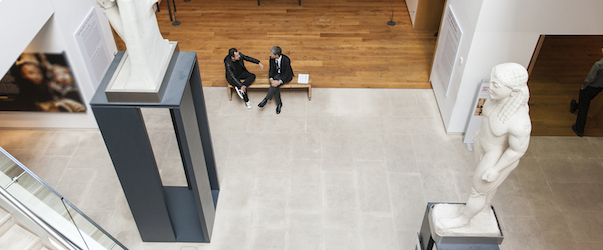As part of the Humanitas series for 2014, Michael Govan (Director and CEO of Los Angeles County Museum of Art – LACMA) discussed the major redevelopment plans he has for the museum and how museums today are, by their very nature, interdisciplinary.
LACMA is a relatively new museum, established in the 1960s, which is contrasted by Govan’s delivery of his lectures at the Ashmolean Museum in Oxford – the first Museum in Britain. But the age of the Ashmolean does not mean ‘old’ in its development or thinking. Like the plans for LACMA, the Ashmolean was recently transformed with a £61 million redevelopment, completed in 2009. The grade-listed original building was retained but the extensions demolished, redesigned and a new building – doubling the gallery space – rebuilt on the same footprint. The reinterpretation of the collections and research across the institutional boundaries determined the new layout at an architectural and thematic level within the galleries. By using the theme of ‘crossing cultures, crossing time’ the typical subject boundaries in the use of displaying objects were broken and a new methodology of interpretation used in the galleries.
Museums play an important part in the structure of society. They are a place to welcome visitors, outreach into communities and communicate through objects and displays. Most importantly, they are a place that anyone can go to. As collecting has developed since the 15th Century, museology and studying collections has moved on from ‘cabinets of curiosities’ to interpreted groups of objects. The Ashmolean original collections were from a ‘cabinet of curiosity’ which was given by Elias Ashmole to Oxford University in order to establish the first museum in Britain in 1683. Cabinets of curiosity were naturally across disciplines as collectors gathered what fascinated them from a scientific, human interest and from particular rarely visited geographic locations or archaeological items from unknown time periods. Categorisation of collections means that the lines between them have been heavily defined as further research and understanding developed. Moves to break, blur and transcend category boundaries have been achieved through the re-interpretation of collections and display in museums and galleries and led to wider consideration of ideas and relationships.

Govan’s plans for LACMA are also transformative. This very ‘new’ institution was established in 1965 when LA was still in its infancy of development. Govan’s plans for the museum will guide the visitors’ focus less on the physical building itself and more on the objects and artist installations inside and outside. By creating what is designed to be a curved glass series of building structures, the new LACMA will be a combination of art, space and experiences. Even when the museum is shut, people will be able to see the artworks through the glass building. Govan continually engages and focuses on the relationship between the artist and the museum, as illustrated by some of the major works at LACMA. Chris Burden’s ‘Urban Lights’ is a huge installation of over 200 streetlamps from the 1920s and 30s. The grouping welcomes visitors to the entrance of the museum. It appeals to visitors and has been used as the location for music videos for Pharrell Williams, Tori Amos and even an advert for Guinness. Michael Heizer’s ‘Levitated Mass’ is an installation which was 40 years in development as the artist searched for the right boulder. At 340 tons and 21.5 feet tall, this boulder was installed over the top of a 456 feet long trench, through which the public can walk and view the mass from all angles, including directly underneath. This particular project was estimated at a cost of $10 million.
The radical and visionary thinking combined with the fundraising capabilities of Govan will make for interesting developments over the coming years. In a world where museums are facing huge cuts and structural and cultural change in order to fit into this changing environment, it is both impressive and inspiring to see that Museums are still able to break new ground and break disciplinary boundaries.
KEY CONTRIBUTORS:
Oxford University:
– TORCH | The Oxford Research Centre in the Humanities www.torch.ox.ac.uk
– Humanitas Visiting Professor Programme www.torch.ox.ac.uk/humanitas
Institute for Strategic Dialogue www.strategicdialogue.org
LACMA – Los Angeles County Museum of Art www.lacma.org
Back to top




